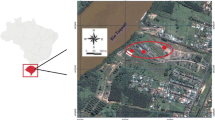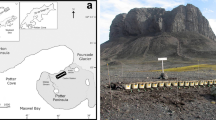Abstract
Bioremediation was performed in situ at a former military range site to assess the performance of native bacteria in degrading hexahydro-1,3,5-trinitro-1,3,5-triazine (RDX) and 2,4-dinitrotoluene (2,4-DNT). The fate of these pollutants in soil and soil pore water was investigated as influenced by waste glycerol amendment to the soil. Following waste glycerol application, there was an accumulation of organic carbon that promoted microbial activity, converting organic carbon into acetate and propionate, which are intermediate compounds in anaerobic processes. This augmentation of anaerobic activity strongly correlated to a noticeable reduction in RDX concentrations in the amended soil. Changes in concentrations of RDX in pore water were similar to those observed in the soil suggesting that RDX leaching from the soil matrix, and treatment with waste glycerol, contributed to the enhanced removal of RDX from the water and soil. This was not the case with 2,4-DNT, which was neither found in pore water nor affected by the waste glycerol treatment. Results from saturated conditions and Synthetic Precipitation Leaching Procedure testing, to investigate the environmental fate of 2,4-DNT, indicated that 2,4-DNT found on site was relatively inert and was likely to remain in its current state on the site.





Similar content being viewed by others
References
Achtnich C, Sieglen U, Knackmuss HJ, Lenke H (1999) Irreversible binding of biologically reduced 2,4,6-trinitrotoluene to soil. Environ Toxicol Chem 18:2416–2423
Achtnich C, Lenke H (2001) Stability of immobilized 2,4,6-trinitrotoluene metabolites in soil under long-term leaching conditions. Environ Toxicol Chem 20:280–283
Adrian NR, Arnett CM, Hickey RF (2003) Stimulating the anaerobic biodegradation of explosives by the addition of hydrogen or electron donors that produce hydrogen. Water Res 37:3499–3507
Adrian NR, Arnett CM (2006) Hexahydro-1,3,5-trinitro-1,3,5-triazine (RDX) serves as a carbon and energy source for a mixed culture under anaerobic conditions. Curr Microbiol 53:129–134
Adrian NR, Arnett CM (2007) Anaerobic biotransformation of explosives in aquifer slurries amended with ethanol and propylene glycol. Chemosphere 66:1849–1856
Behrooz M, Borden RC (2012) Waste glycerol addition to reduce AMD production in unsaturated mine tailings. Mine Water Environ 31:161–171
Bhatt M, Zhao JS, Halasz A, Hawari J (2006) Biodegradation of hexahydro-1,3,5-trinitro-1,3,5-triazine by novel fungi isolated from unexploded ordnance contaminated marine sediment. J Ind Microbiol Biotechnol 33:850–858
Boopathy R, Widrig DL, Manning JF (1997) In situ bioremediation of explosives-contaminated soil: a soil column study. Bioresour Technol 59:169–176
Boopathy R, Manning J, Kulpa CF (1998) Biotransformation of explosives by anaerobic consortia in liquid culture and in soil slurry. Int Biodeterior Biodegrad 41:67–74
Boopathy R (2001) Enhanced biodegradation of cyclotetramethylenetetranitramine (HMX) under mixed electron-acceptor condition. Bioresour Technol 76:241–244
Bradley PM, Chapelle FH (1995) Factors affecting microbial 2,4,6-trinitrotoluene mineralization in contaminated soil. Environ Sci Technol 29:802–806
Cheng J, Suidan MT, Venosa AD (1998) Anaerobic biotransformation of 2,4-dinitrotoluene with ethanol, methanol, acetic acid and hydrogen as primary substrates. Water Res 32:2921–2930
Chu A, Mavinic DS, Kelly HG, Ramey W (1994) Volatile fatty acid production in thermophilic aerobic digestion of sludge. Water Res 28:1513–1522
Clausen J, Robb J, Curry D, Korte N (2004) A case study of contaminants on military ranges: Camp Edwards, Massachusetts, USA. Environ Pollut 129:13–21
Colucci JA, Borrero EE, Alape F (2005) Biodiesel from an alkaline transesterification reaction of soybean oil using ultrasonic mixing. J Am Oil Chem Soc 82:525–530
Crockett AB, Craig HD, Jenkins TF, Sisk WE (1998) Overview of on-site analytical methods for explosives in soil. U.S. Army Corps of Engineers, Cold Regions Research and Engineering Laboratory (CRREL), Hanover
Dontsova KM, Yost SL, Šimunek J, Pennington JC, Williford CW (2006) Dissolution and transport of TNT, RDX, and composition B in saturated soil columns. J Environ Qual 35:2043–2054
Dontsova KM, Pennington JC, Hayes C, Šimunek J, Williford CW (2009) Dissolution and transport of 2,4-DNT and 2,6-DNT from M1 propellant in soil. Chemosphere 77:597–603
Fahrenfeld N, Zoeckler J, Widdowson MA, Pruden A (2013) Effect of biostimulants on 2,4,6-trinitrotoluene (TNT) degradation and bacterial community composition in contaminated aquifer sediment enrichments. Biodegradation 24:179–190
Fuller ME, Manning JF Jr (2004) Microbiological changes during bioremediation of explosives-contaminated soils in laboratory and pilot-scale bioslurry reactors. Bioresour Technol 91:123–133
Funk SB, Roberts DJ, Crawford DL, Crawford RL (1993) Initial-phase optimization for bioremediation of munition compound-contaminated soils. Appl Environ Microbiol 59:2171–2177
Gerlach R, Steiof M, Zhang C, Hughes JB (1999) Low aqueous solubility electron donors for the reduction of nitroaromatics in anaerobic sediments. J Contam Hydrol 36:91–104
Gnanapragasam G, Senthilkumar M, Arutchelvan V, Velayutham T, Nagarajan S (2011) Bio-kinetic analysis on treatment of textile dye wastewater using anaerobic batch reactor. Bioresour Technol 102:627–632
Hawari J, Halasz A (2000) Biodegradation of explosives. In: Bitton G (ed) Encyclopedia of Environmental Microbiology. Wiley, New York, pp 1979–1993
Hudcova T, Halecky M, Kozliak E, Stiborova M, Paca J (2011) Aerobic degradation of 2,4-dinitrotoluene by individual bacterial strains and defined mixed population in submerged cultures. J Hazard Mater 192:605–613
Hughes JB, Wang CY, Zhang C (1999) Anaerobic biotransformation of 2,4-dinitrotoluene and 2,6-dinitrotoluene by Clostridium acetobutylicum: a pathway through dihydroxylamino intermediates. Environ Sci Technol 33:1065–1070
Hundal LS, Shea PJ, Comfort SD, Powers WL, Singh J (1997) Long-term TNT sorption and bound residue formation in soil. J Environ Qual 26:896–904
Innemanová P, Velebová R, Filipová A, Čvančarová M, Pokorný P, Němeček J, Cajthaml T (2015) Anaerobic in situ biodegradation of TNT using whey as an electron donor: a case study. New Biotechnol 32:701–709
Jenkins TF, Grant CL, Walsh ME, Thorne PG, Thiboutot S, Ampleman G, Ranney TA (1999) Coping with spatial heterogeneity effects on sampling and analysis at an HMX-contaminated antitank firing range. Field Anal Chem Technol 3:19–28
Jugnia L-B, Beaumier D, Holdner J, Delisle S, Greer CW, Hendry M (2017) Enhancing the potential for in situ bioremediation of RDX contaminated soil from a former military demolition range. Soil Sediment Contam Int J 26(7–8):722–735
Kanekar SP, Kanekar PP, Sarnaik SS, Gujrathi NP, Shede PN, Kedargol MR, Reardon KF (2009) Bioremediation of nitroexplosive wastewater by an yeast isolate Pichia sydowiorum MCM Y-3 in fixed film bioreactor. J Ind Microbiol Biotechnol 36:253–260
Lamichhane KM, Babcock RW Jr, Turnbull SJ, Schenck S (2012) Molasses enhanced phyto and bioremediation treatability study of explosives contaminated Hawaiian soils. J Hazard Mater 243:334–339
Lee D-J, Lee S-Y, Bae J-S, Kang J-G, Kim K-H, Rhee S-S, Park J-H, Cho J-S, Chung J, Seo D-C (2015) Effect of volatile fatty acid concentration on anaerobic degradation rate from field anaerobic digestion facilities treating food waste leachate in South Korea. J Chem 2015:1–9
Lendenmann U, Spain JC, Smets BF (1998) Simultaneous biodegradation of 2,4-dinitrotoluene and 2,6-dinitrotoluene in an aerobic fluidized-bed biofilm reactor. Environ Sci Technol 32:82–87
Lenke H, Warrelmann J, Daun G, Hund K, Sieglen U, Walter U, Knackmuss HJ (1998) Biological treatment of TNT-contaminated soil. 2. Biologically induced immobilization of the contaminants and full-scale application. Environ Sci Technol 32:1964–1971
Lewis TA, Newcombe DA, Crawford RL (2004) Bioremediation of soils contaminated with explosives. J Environ Manag 70:291–307
Lynch JC, Brannon JM, Delfino JJ (2002) Effects of component interactions on the aqueous solubilities and dissolution rates of the explosive formulations octol, composition B, and LX-14. J Chem Eng Data 47:542–549
Mamma D, Kalogeris E, Papadopoulos N, Hatzinikolaou DG, Christrakopoulos P, Kekos D (2004) Biodegradation of phenol by acclimatized Pseudomonas putida cells using glucose as an added growth substrate. J Environ Sci Health A Tox Hazard Subst Environ Eng 39:2093–2104
McCormick NG, Cornell JH, Kaplan AM (1981) Biodegradation of hexahydro-1,3,5-trinitro-1,3,5-triazine. Appl Environ Microbiol 42:817–823
Meyers SK, Deng S, Basta NT, Clarkson WW, Wilber GG (2007) Long-term explosive contamination in soil: effects on soil microbial community and bioremediation. Soil Sediment Contam 16:61–77
Michalsen MM, Weiss R, King A, Gent D, Medina VF, Istok JD (2013) Push-pull tests for estimating rdx and tnt degradation rates in groundwater. Ground Water Monit Remidiat 33:61–68
NRC (2010) Detailed site characterization at the demolition range—CFB Petawawa, report fiscal year 2009–2010. National Research Council, Biotechnology Research Institute
Oh BT, Just CL, Alvarez PJJ (2001) Hexahydro-1,3,5-trinitro-1,3,5-triazine mineralization by zerovalent iron and mixed anaerobic cultures. Environ Sci Technol 35:4341–4346
Paca J, Halecky M, Barta J, Bajpai R (2009) Aerobic biodegradation of 2,4-DNT and 2,6-DNT: performance characteristics and biofilm composition changes in continuous packed-bed bioreactors. J Hazard Mater 163:848–854
Payne ZM, Lamichhane KM, Babcock RW Jr, Turnbull SJ (2013) Pilot-scale in situ bioremediation of HMX and RDX in soil pore water in Hawaii. Environ Sci Processes Impacts 15:2023–2029
Pennington JC, Brannon JM (2002) Environmental fate of explosives. Thermochim Acta 384:163–172
Phelan JM, Barnett JL (2001) Solubility of 2,4-dinitrotoluene and 2,4,6-trinitrotoluene in water. J Chem Eng Data 46:375–376
Pichtel J (2012) Distribution and fate of military explosives and propellants in soil: a review. Appl Environ Soil Sci 2012:1–33
Radtke CW, Gianotto D, Roberto FF (2002) Effects of particulate explosives on estimating contamination at a historical explosives testing area. Chemosphere 46:3–9
Ringelberg D, Richmond M, Foley K, Reynolds C (2008) Utility of lipid biomarkers in support of bioremediation efforts at army sites. J Microbiol Methods 74:17–25
Ringelberg DB, Reynolds CM, Walsh ME, Jenkins TF (2003) RDX loss in a surface soil under saturated and well drained conditions. J Environ Qual 32:1244–1249
Rodgers JD, Bunce NJ (2001) Treatment methods for the remediation of nitroaromatic explosives. Water Res 35:2101–2111
Ronen Z, Yanovich Y, Goldin R, Adar E (2008) Metabolism of the explosive hexahydro-1,3,5-trinitro-1,3,5-triazine (RDX) in a contaminated vadose zone. Chemosphere 73:1492–1498
Speitel GE Jr, Engels TL, McKinney DC (2010) Biodegradation of RDX in unsaturated soil. Biorem J 5:1–11
Stevenson FJ, Fitch A (1986) Chemistry of complexation of metal ions with soil solution organics. In: Huang PM, Schnitzer M (eds) Interactions of Soil Minerals with Natural Organics and Microbes. Soil Science Society of America, Madison, pp 29–58
Tharakan JP, Gordon JA (1999) Cometabolic biotransformation of trinitrotoluene (TNT) supported by aromatic and non-aromatic cosubstrates. Chemosphere 38:1323–1330
USEPA (1994) Toxicity characteristic leaching procedure, test methods for evaluating solid waste, physical/chemical methods U.S. Environmental Protection Agency, Office of Solid Waste, U.S. Government Printing Office, Washington
USEPA (1997) Nitroaromatics and nitramines by high performance liquid chromatography (HPLC), test methods for evaluating solid waste; SW-846 update III; part 4: 1 (B). Office of Solid Waste, Washington, DC
Wang CC, Lee CM, Lu CJ, Chuang MS, Huang CZ (2000) Biodegradation of 2,4,6-trichlorophenol in the presence of primary substrate by immobilized pure culture bacteria. Chemosphere 41:1873–1879
Zhang C, Hughes JB, Nishino SF, Spain JC (2000) Slurry-phase biological treatment of 2,4-dinitrotoluene and 2,6-dinitrotoluene: role of bioaugmentation and effects of high dinitrotoluene concentrations. Environ Sci Technol 34:2810–2816
Acknowledgments
We thank the four CDSB Environment Services of the Canadian Department of National Defense at Garrison Petawawa for funding of this work. We thank N. Kemka for assistance with field work, A. Halasz for technical support, and L. Paquet and A. Corriveau for the analytical support.
Author information
Authors and Affiliations
Corresponding author
Additional information
Responsible editor: Zhihong Xu
Rights and permissions
About this article
Cite this article
Jugnia, L.B., Manno, D., Drouin, K. et al. In situ pilot test for bioremediation of energetic compound-contaminated soil at a former military demolition range site. Environ Sci Pollut Res 25, 19436–19445 (2018). https://doi.org/10.1007/s11356-018-2115-y
Received:
Accepted:
Published:
Issue Date:
DOI: https://doi.org/10.1007/s11356-018-2115-y




